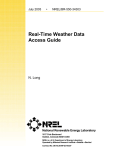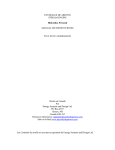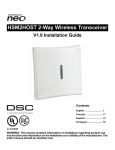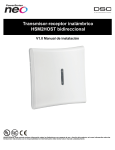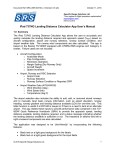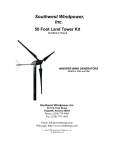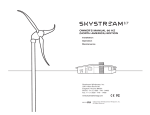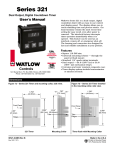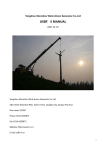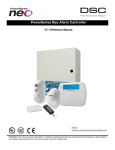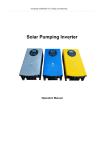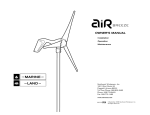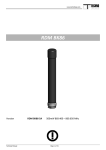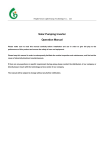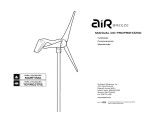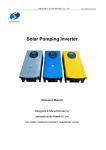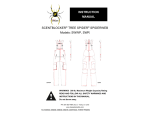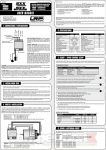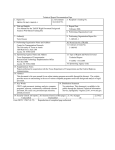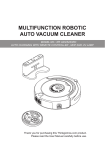Download Certification Testing for Small Wind Turbines
Transcript
October 1999 • NREL/CP-500-27062 Certification Testing for Small Wind Turbines D. Corbus, H. Link, S. Butterfield, C. Stork, and C. Newcomb National Renewable Energy Laboratory T. Sasseen Southwest Windpower Presented at Windpower ‘99 Burlington, Vermont June 20–23, 1999 National Renewable Energy Laboratory 1617 Cole Boulevard Golden, Colorado 80401-3393 NREL is a U.S. Department of Energy Laboratory Operated by Midwest Research Institute • Battelle • Bechtel Contract No. DE-AC36-98-GO10337 NOTICE This report was prepared as an account of work sponsored by an agency of the United States government. Neither the United States government nor any agency thereof, nor any of their employees, makes any warranty, express or implied, or assumes any legal liability or responsibility for the accuracy, completeness, or usefulness of any information, apparatus, product, or process disclosed, or represents that its use would not infringe privately owned rights. Reference herein to any specific commercial product, process, or service by trade name, trademark, manufacturer, or otherwise does not necessarily constitute or imply its endorsement, recommendation, or favoring by the United States government or any agency thereof. The views and opinions of authors expressed herein do not necessarily state or reflect those of the United States government or any agency thereof. Available to DOE and DOE contractors from: Office of Scientific and Technical Information (OSTI) P.O. Box 62 Oak Ridge, TN 37831 Prices available by calling 423-576-8401 Available to the public from: National Technical Information Service (NTIS) U.S. Department of Commerce 5285 Port Royal Road Springfield, VA 22161 703-605-6000 or 800-553-6847 or DOE Information Bridge http://www.doe.gov/bridge/home.html Printed on paper containing at least 50% wastepaper, including 20% postconsumer waste CERTIFICATION TESTING FOR SMALL WIND TURBINES Dave Corbus, Hal Link, Sandy Butterfield, Christof Stork, Charles Newcomb National Renewable Energy Laboratory 1617 Cole Blvd. Golden, CO 80401 Tim Sasseen Southwest Windpower 2131 N. First St. Flagstaff, AZ 86003 1.0 Background This paper describes the testing procedures for obtaining type certification for a small wind turbine. Southwest Windpower (SWWP) is seeking type certification from Underwriters Laboratory (UL) for the AIR 403 wind turbine. UL is the certification body and the National Renewable Energy Laboratory (NREL) is providing technical assistance including conducting the certification testing. This is the first small turbine to be certified in the United States, therefore standards must be interpreted and test procedures developed. 2.0 Description of the Turbine The AIR 403 is a small battery-charging turbine rated to produce 400 watts in a 12.5 meters per second (m/s) (28 mph) wind speed. The turbine is generally used either as a stand-alone battery charging system or in conjunction with a small photovoltaic (PV) array as a wind-PV hybrid system to power loads such as lighting, TV, and small household appliances. The AIR 403 turbine is also very popular on sailboats for on-board power. The AIR 403 uses a brushless permanent magnet alternator to produce three-phase variable alternating current (AC) output that is then rectified to direct current (DC). The rectifier and charge controller for the turbine are housed in the nacelle of the turbine and are directly heat-sinked to the turbine body. The turbine rotor diameter is 1.15 meters (4 ft), the weight is 5.85 kilograms (13 lb), and the turbine is available in 12-, 24-, and 48-volt configurations. The cut-in wind speed of the turbine is 2.7 m/s (6 mph). The turbine has a brake switch that shorts the turbine output wires together and results in the turbine stopping. The turbine blades are made from injected-molded carbon fiber. In winds above about 18.8 m/s (42 mph), the carbon-fiber blades will go into flutter to protect the turbine from overspeeding. This is called aeroelastic stall in the user’s manual (Southwest Windpower 1999). During normal turbine operation (i.e., turbine connected to batteries), the turbine regulator will brake the turbine to a very slow rotational speed when the batteries are fully charged. During open-circuit operation of the turbine (i.e., turbine disconnected from the batteries), the turbine regulator will brake the turbine to prevent overspeed and to prevent the output voltage from rising above double the rated voltage of the turbine. Figure 1 shows a picture of the AIR 403. Table 1 lists the basic turbine specifications and operational data. 1 FIGURE 1. THE AIR 403 TABLE 1. TEST TURBINE CONFIGURATION AND OPERATIONAL DATA Test Turbine General Configuration Make, Model, Serial Number Southwest Windpower AIR 403, #19825 Rotation Axis (H / V) H Orientation (upwind / downwind) Upwind Number of Blades 3 Rotor Diameter (m) 1.15 m (4 ft) Hub Height as tested (m) 13.7 m (45 ft) Operation Rated Electrical Power (W) 400 Rated Wind Speed (m/s) 12.5 (28 mph) Cut-in Wind Speed (m/s) 2.7 (6 mph) Rotor Swept Area (m2) 1.8 (19.4 ft2) Blade Pitch Angle (deg) 2.5 Direction of Rotation Clockwise 2 Tower Type Tubular (schedule 40 pipe) guyed tilt-up Height 13.7 m (40 ft ) with 1.5 m (5 ft) adapter Control and Electrical System Controller: Make, Type Autobrake, rectifier/charge controller Electrical Output Voltage Nominal 12 volts (24- and 48-volt versions available) 3.0 Certification Testing Overview Figure 2 shows an overview of the requirements for small wind turbine type certification. Specific tests are required under “type testing.” Optional but desirable tests are shown under “type characteristics measurements.” However, the blade tests and load measurements required under type testing for large turbines can be waived in lieu of a “duration test” per IEC 61400-22 Annex E. Also required under type testing is a safety and function test. SWWP chose to certify a power curve for their turbine, therefore a power performance test is being conducted according to the requirements of IEC 61400-12. The safety and function, duration, and power performance tests are the three main tests required for the certification of the AIR 403. NREL has written a detailed test plan for each test being conducted that describes the testing approach, configuration, and procedures. NREL is also obtaining some additional data on the SWWP turbine’s characteristics in order to provide inputs to the design evaluation process. Design Evaluation Type Testing Safety and Function Test Duration Test Manufacturing Evaluation Final Evaluation Report Foundation Design Evaluation Type Characteristic Measurement Power Performance Test Type Certificate FIGURE 2. TESTS REQUIRED FOR SMALL WIND TURBINE CERTIFICATION 3 3.1 Safety and Function Test The purpose of the safety and function test is to verify that the turbine has adequate provisions to operate safely under all conditions. It is conducted in accordance with provisions listed in IEC 61400-22 Annex D. For larger turbines, this testing focuses on the control system for the turbine. However, the control systems for small turbines are very simple and often passive. For the AIR 403 turbine, the safety and function test consists of the following: Emergency shutdown operation. Conduct a brake test to ensure the turbine stops in high winds when the brake is applied. Power and speed control. Verify that the aero-elastic stall mechanism of the blades limits speed and power and verify that the charge controller limits current in high winds when the battery voltage is greater or equal to the charge controller voltage set-point. Yaw control. Visual inspection, if problems are noted a test plan will be developed. Grid loss behavior. Open circuit test includes 4 Hz sampling of current to verify internal braking mechanism of turbine controller reduces current to zero. Over-speed protection. Verify blade "aeroelastic stall" reduces current output. The above tests are contained in a checklist and capture the intent of the IEC 61400-2 Annex D requirements without making the testing so burdensome and expensive that small turbine manufacturers would be unable to afford the it. For example, visual inspection of adequate yaw control is relatively inexpensive compared to instrumenting, recording, and analyzing yaw and wind direction signals. 3.2 Duration Test As mentioned previously, the duration test may replace the blade tests and load measurements required under type testing for small turbines. This variance from the large turbine standard can help reduce the cost of testing small turbines because it is usually easier to conduct a duration test as opposed to blade and load tests. The IEC 61400-2 Annex E requires that the turbine undergo testing for 1,500 hours of power generation and six months test duration, as well as operation in winds greater than 10 m/s (22 mph) for 250 hours and operation in winds greater than 15 m/s (33 mph) for 25 hours. The operating requirements per IEC 61400-2 Annex E are that the turbine achieve at least 90% availability. In addition to the availability requirement, NREL requires that the turbine’s monthly energy production throughout the test be no less than 20% of the first month’s energy production after correction for wind resource differences. A 20% change in the monthly energy production would indicate a problem with yaw bearings, blades, bearings, generator, or the rectifier. To compare energy production, both the expected energy production and measured energy production are determined. Expected energy production is the energy that would have been produced under the measured wind conditions if the turbine operated on its power curve as measured during the first month. Measured energy production is energy that the turbine actually produced as measured by the power transducer. The comparison uses data obtained when turbine and anemometer are clear of wakes from any obstacles and when the winds are within the range of the power curve measured during the first month of duration testing. Another requirement by NREL for the duration test is that the turbine maintains its ability to reduce power output when the batteries are fully charged. NREL has developed a procedure to test the charge controller to verify that it operates during the entire duration test. The turbine is connected to the battery 4 bank near full SOC and current output from the turbine observed as the battery approaches the voltage set-point of the turbine charge controller. Upon reaching the charge controller voltage set-point, the turbine current output is verified to be reduced below 3 amps. This test will be conducted at least three times, including the beginning, middle, and end of the duration test. The final requirement by NREL for the duration test is that there is no abnormal wear. Abnormal wear will be noted in the final component wear and durability assessment. At the completion of the duration test the turbine will be taken down from the tower and a detailed component wear and durability checklist for the entire turbine will be conducted. It will include an assessment of the physical integrity of the blades noting any cracks or abnormal surface conditions, the mechanical alignment of the rotor, and an analysis of the charge controller including any signs of thermal degradation. The following measurements will be taken during the duration test: power production, turbine availability, wind speed consisting of 10-minute average, 3-second gust, and turbulence intensity and wind direction. NREL has included wind direction to avoid using data obtained when upwind obstacles affect the turbine or anemometer. Power is measured by a power transducer and also calculated from current and voltage measurements for the duration test. Voltage measurements are taken at the top of the wind turbine tower and also at the battery bank, so that the line losses can be calculated. The AIR 403 is available in a 12-, 24-, and 48-volt version; the 12-volt version was selected for the duration test because it produces the highest current, and, therefore, the highest thermal loading. Turbine availability is determined from the test log and supplemented by a manual switch connected to the data acquisition system. If NREL staff note any problems with the turbine the switch is thrown and an entry is made in the log. This method avoids the undesirable loss of availability when the turbine is shut down for instrumentation changes or special tests. The arrangement for the AIR 403 duration test, including the measured parameters for the data acquisition system, is shown in Figure 3. The battery bank voltage in the duration test is varied by means of applying a constant resistance load in series with a low- voltage disconnect (LVD). The load will be used to lower the battery bank voltage to the LVD set point (equal to about 40% state of charge) at which point the load will automatically disconnect. The reset voltage of the LVD will correspond to full battery state-of charge (SOC). Hence the LVD will keep the load disconnected until the turbine recharges the batteries back to the 100% SOC. When the batteries are once again charged, the LVD will reconnect the load and the batteries will again discharge. The load will vary about 15% because it is a fixed resistance and the voltage changes with battery SOC. In addition, the discharge rate of the batteries will vary depending on the turbine output. The turbine charge controller will regulate current when the batteries reach 100% SOC and hence the charge controller will be tested every time the batteries reach 100% SOC. Also included in the type certification for the turbine is the tower for the AIR 403. The tower is a guyed, tilt-up tower made from schedule 40 pipe. The turbine will be tested with this tower to ensure that the tower is designed for all the loads encountered during the duration test including the 25 hours of wind speeds greater than 15 m/s (33 mph). 5 Southwest Windpower AIR 403 Wind Module Southwest Windpower AIR 403 Duration Test Layout Wind Vane Wind speed Turbine DC Volts Turbine DC Amps Turbine DC Power Wind Speed/direction Brake Status LVD Lightning Arrestor Voltage taps DAS: 300W Brake Battery Bank (Trojan L-16, 700 Ah) FIGURE 3. AIR 403 DURATION TEST SCHEMATIC 3.3 Power Performance Test The power performance test follows the IEC 61400-12 standard except that changes are required to account for the effect that battery state-of-charge (i.e., voltage variation in the load) has on power output. The electrical load is controlled at voltages corresponding to a battery SOC of approximately 40%, 70%, and 100%, and 60 hours of operation is required for each SOC voltage. In addition, for each of the three voltage settings, 30 minutes of data is required for each 0.5 m/s (1 mph) wind speed bin. Because this is the first power performance test for a small wind turbine certification, the variation of the power curve as a function of voltage will be evaluated to determine the sensitivity of the power curve to battery SOC. If the voltage variation has a small effect on the power output, then the final power curve will be an average of the three voltages. If voltage has a significant effect on the power curve output (e.g., greater than 5%), then the power curves corresponding to the three voltage settings may be shown separately. The AIR 403 is available in three different nominal voltages: 12-, 24-, and 48-volts. It is anticipated that the power output will be slightly higher as the nominal turbine voltage increases, hence three separate power performance tests will be conducted corresponding to the three nominal voltage versions of the turbine. It is anticipated that the nominal voltage rating of the turbine will have a larger impact on the power curve than the voltage variation corresponding to battery-state-of-charge. Hence the data requirements for voltage variations as a function of battery state-of-charge may be relaxed for tests of 24volt and 48-volt AIR 403 turbine versions. A second change from the IEC 61400-12 standard is accommodation of the charge controller. The power performance test will be conducted so that the charge controller does not have any effect on the power 6 output. This will be done by setting the charge controller voltage above that of the load so that the charge controller never regulates current. Voltage control of the load will be maintained using Alternative Engineering’s Enermaxer load controller configured to maintain voltage within 2% of the desired setting. The Enermaxer load controller uses pulse-width modulation to control current to a dump load and thereby maintain voltage control. Per IEC 61400-12, the anemometer must be located between 2 and 4 rotor diameters from the turbine. In this test the anemometer will be mounted 2.5 rotor diameters from the turbine. Another anemometer is located approximately 15 m (50 feet) from the turbine tower as a check on the primary anemometer. An assessment will be made to determine if there are any significant anemometer wake effects on the turbine from the primary anemometer. Figure 4 shows the layout for the power performance test. Turbine Tower Anemometer AIR403 8 7 6 5 4 3 2 1H H H H H 1 H H L L L PU L 6 RO NT 4 5 CO 3 L CIT EX H L L L L N IO AT 4 O CA 2 1 TS PU 4 E IN 3 LS 1 Wind Speed Wind Direction Barometric Pressure Temperature Wetness Sensor +12 2 2 1 3 2 DAS Power Transducer Load (14000W) Current Sensor Batt Load Batt Load + + - Voltage Sensing Enermaxer Load Control Batteries FIGURE 4. TURBINE CONFIGURATION FOR POWER PERFORMANCE TEST 3.4 Verification of Design Assumptions The three main certification tests for small turbines shown in Figure 2 fall under “type testing” and “type characteristic measurements.” However, the “design evaluation” process according to IEC 61400-2 is based on assumptions and/or measurements of the following parameters: rated and maximum rotor speed and power, and maximum yaw rate. As part of the duration and/or power performance test, these parameters will be measured. The maximum and rated rpm can be calculated by measuring the frequency of the AC ripple downstream of the rectifier on the DC bus and calculating wind turbine rpm based on frequency and the number of poles in the generator. The maximum yaw rate will be estimated by using a video camera at slow speed to measure yaw in degrees for a given time interval. Simplifying the yaw rate 7 measurement by using a video camera, as opposed to instrumenting the turbine with an expensive yaw sensor set-up, helps to reduce the complexity and costs for small certification testing. 4.0 Future Work in Small Wind Turbine Certification Testing Small wind turbine certification testing is just starting, with the AIR 403 certification test being the first certification test in the United States. Work is now beginning on a revision of IEC 61400-22. Lessons learned from the current certification testing will be incorporated in the IEC 61400-22 revision and into future certification testing protocols. NREL will continue to develop small wind turbine testing capabilities and to share information. References Standard IEC 61400-22, International Electrotechnical Commission (IEC), Draft Wind Turbine Generator Systems Part 22: Wind Turbine, 88/102/CD, 18 Dec. 1998. Standard IEC 61400-2, International Electrotechnical Commission (IEC), Wind Turbine Generator Systems Part 2: Wind Turbine, 18 Dec. 1996-04. Standard IEC 61400-22, International Electrotechnical Commission (IEC), Wind Turbine Generator Systems Part 12 – Wind Turbines Power Performance Testing: Wind Turbine, 88/66/CDV, 1997-10-03. AIR 403 Owner’s Manual, Southwest Windpower, Flagstaff AZ, 1999. 8










